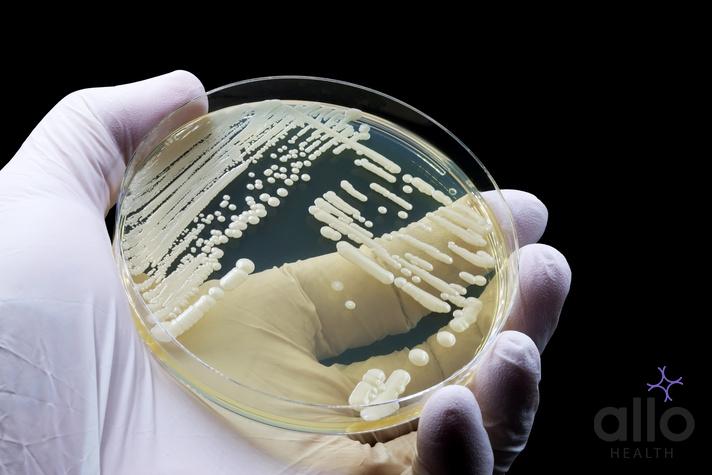What is Candidiasis (Yeast Infection)?

Allo Health is dedicated to personalized well-being, offering support and trusted information tailored to individual health goals. The platform emphasizes human-generated content, led by a distinguished medical team of experts, including physicians and sexual health specialists. Their commitment to credibility involves rigorous fact-checking, authoritative research, and continuous updates to ensure accurate, up-to-date information. Allo Health's unique approach goes beyond conventional platforms, providing expert-led insights and a continuous commitment to excellence, with user feedback playing a crucial role in shaping the platform's authoritative voice.

Dr Thanushree, has her MBBS from Kanachur Institute of Medical Sciences, Mangalore
Why This Was Upated?
Our experts continually monitor the health and wellness space, and we update our articles when new information became available.
Updated on 20 June, 2025
- Article was updated as part of our commitment to diversity, equity, and inclusion.
Candidiasis, commonly known as a yeast infection, is a fungal infection caused by the overgrowth of Candida species, typically Candida albicans. While Candida is naturally present in small amounts in the body, certain conditions can lead to its overgrowth, resulting in various forms of infection. Candidiasis can affect different parts of the body, including the mouth, throat, genitals, and skin. In this comprehensive guide, we will delve into the details of Candidiasis, exploring its symptoms, causes, diagnosis, treatment options, and prevention strategies.
Symptoms of Candidiasis
The symptoms of Candidiasis can vary depending on the affected area of the body. Here are some common manifestations:
- Genital Yeast Infection:
- Itching and irritation in the genital area.
- Burning sensation, especially during urination or intercourse.
- Redness and swelling of the vulva.
- Cottage cheese-like discharge from the vagina in women.
- Oral Thrush:
- White, creamy patches on the tongue, inner cheeks, gums, or throat.
- Soreness and difficulty swallowing.
- Loss of taste.
- Skin Infections:
- Red, itchy rash with raised borders.
- Patches of small blisters or pustules.
- Cracking or peeling of the skin.
- Invasive Candidiasis (Systemic Infection):
- Fever and chills.
- Rapidly worsening symptoms.
- Septic shock (in severe cases)

Causes of Candidiasis
Several factors can contribute to the overgrowth of Candida, leading to Candidiasis. These include:
- Weakened Immune System: Individuals with compromised immune systems, such as those with HIV/AIDS, cancer, or autoimmune diseases, are more susceptible to Candidiasis.
- Antibiotic Use: Antibiotics can disrupt the balance of bacteria in the body, allowing Candida to proliferate unchecked. This is because antibiotics not only kill harmful bacteria but also beneficial bacteria that help keep Candida in check.
- Diabetes: Poorly controlled diabetes can lead to elevated levels of sugar in bodily fluids, providing an ideal environment for Candida to thrive.
- Pregnancy: Hormonal changes during pregnancy can alter the vaginal environment, increasing the risk of vaginal yeast infections.
- Uncontrolled Diabetes: Individuals with diabetes are more prone to yeast infections due to elevated blood sugar levels, which create a favorable environment for yeast growth.
- Poor Hygiene: Inadequate hygiene, especially in moist areas of the body such as the genitals and skin folds, can promote yeast overgrowth.
- High Sugar Diet: Excessive consumption of sugary foods and beverages can feed Candida, allowing it to multiply rapidly.
Diagnosis of Candidiasis
Diagnosing Candidiasis typically involves a combination of medical history review, physical examination, and laboratory tests. The healthcare provider may:
- Conduct a Physical Examination: This may involve inspecting the affected area, such as the genitals, mouth, or skin, for characteristic signs of Candidiasis.
- Collect Samples: In cases of oral thrush or genital yeast infections, the healthcare provider may collect samples of the affected tissue or discharge for laboratory analysis.
- Microscopic Examination: Microscopic examination of the collected samples can reveal the presence of Candida organisms, confirming the diagnosis.
- Culture Test: A culture test may be performed to grow Candida organisms in a laboratory setting, allowing for identification and susceptibility testing to determine the most effective treatment.
Treatment of Candidiasis
Treatment for Candidiasis typically involves antifungal medications, which may be administered orally, topically, or intravenously, depending on the severity and location of the infection. Commonly prescribed antifungal agents include:
- Topical Antifungals: For localized infections such as vaginal yeast infections or oral thrush, topical antifungal creams, ointments, or lozenges may be recommended. These medications are applied directly to the affected area.
- Oral Antifungals: For more widespread or severe infections, oral antifungal medications such as fluconazole, itraconazole, or voriconazole may be prescribed. These medications are taken by mouth and work systemically to eliminate the fungal infection.
- Intravenous Antifungals: In cases of invasive Candidiasis or systemic infection, where the infection has spread to internal organs or the bloodstream, intravenous antifungal medications such as amphotericin B or echinocandins may be administered in a hospital setting.
- Adjunctive Therapies: In addition to antifungal medications, other treatments such as probiotics (to restore the balance of beneficial bacteria) and dietary modifications (to reduce sugar intake) may be recommended to support the healing process and prevent recurrence.

Prevention of Candidiasis
While Candidiasis is not always preventable, certain measures can help reduce the risk of infection:
- Practice Good Hygiene: Maintain proper hygiene, especially in areas prone to moisture, such as the genitals and skin folds. Keep these areas clean and dry to prevent yeast overgrowth.
- Avoid Irritants: Avoid using irritating substances such as scented soaps, douches, and feminine hygiene products, which can disrupt the natural balance of bacteria and yeast.
- Manage Underlying Conditions: Control underlying medical conditions such as diabetes, HIV/AIDS, or autoimmune disorders through proper management and medication adherence.
- Limit Antibiotic Use: Use antibiotics judiciously and only when necessary. If you are prescribed antibiotics, consider taking probiotics concurrently to help maintain the balance of beneficial bacteria.
- Maintain a Healthy Diet: Eat a balanced diet rich in fruits, vegetables, whole grains, and lean proteins while limiting sugary and processed foods, which can promote yeast overgrowth.
- Practice Safe Sex: Use condoms during sexual intercourse to reduce the risk of transmitting or acquiring genital yeast infections.
- Manage Stress: Chronic stress can weaken the immune system, making the body more susceptible to infections. Practice stress-reducing techniques such as meditation, yoga, or deep breathing exercises.
Candidiasis, or yeast infection, is a fungal infection caused by the overgrowth of Candida species. While it can affect various parts of the body, including the genitals, mouth, and skin, Candidiasis is typically treatable with antifungal medications. By understanding the symptoms, causes, diagnosis, treatment options, and prevention strategies outlined in this article, individuals can take proactive steps to manage Candidiasis and reduce the risk of recurrence. As always, it is essential to consult with a healthcare provider for proper diagnosis and treatment recommendations tailored to individual needs.
"The following blog article provides general information and insights on various topics. However, it is important to note that the information presented is not intended as professional advice in any specific field or area. The content of this blog is for general educational and informational purposes only.
Book consultation
The content should not be interpreted as endorsement, recommendation, or guarantee of any product, service, or information mentioned. Readers are solely responsible for the decisions and actions they take based on the information provided in this blog. It is essential to exercise individual judgment, critical thinking, and personal responsibility when applying or implementing any information or suggestions discussed in the blog."


